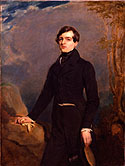X
Please wait for the PDF.
The browser will either open the file, download it, or display a dialog.
The browser will either open the file, download it, or display a dialog.
|
|
|||||||
|
Eugène Delacroix's Portrait of Charles de Verninac, 1825-26
|
|||||||
|
Among notable works of nineteenth-century art to have appeared recently on the art market is a portrait by Eugène Delacroix of his nephew, Charles de Verninac. Although unsigned, the painting is of superior quality and corresponds to Delacroix's style and brushwork of the early to mid-1820s. An ébauche for the portrait (J. 92) remained in Delacroix's studio as a souvenir of his young relative. There also exists a sheet of studies for Charles's head and face, (L. 838). The sheet bears the stamp of the well-known posthumous sale from Delacroix's atelier. | ||||||
| Charles de Verninac was the only son of Delacroix's sister, Henriette de Verninac. Delacroix's junior by only five years, young Charles came to Paris from the country to attend the Lycée Louis le Grand, at which time Delacroix served as his informal guardian. They developed a close relationship that continued when Charles studied law in Paris from 1822-1824 and then stayed to work there. In 1829, Charles joined the diplomatic service, which posted him to Valparaiso, Chile. He must have treasured Delacroix's painting, for he took it with him. On his way home, he contracted Yellow Fever in Vera Cruz, Mexico and died in New York City in 1834. His picture has been in American collections ever since. | |||||||
| Not only is this portrait of interest for its personal and family history, it exemplifies a significant but sparsely documented phase of Delacroix's work during which he drew from British portraiture as a source of inspiration. The most famous work from this “English” period is the Portrait of Louis-Auguste [later Baron] Schwiter (ca. 1826, The National Gallery, London), with which the portrait of Charles de Verninac shares several characteristics. | |||||||
| It is well known that Delacroix visited England for three months, beginning in May 1825, accompanied by two of his English artist friends, Thales Fielding, and Richard Parkes Bonington, with whom Delacroix later shared a studio in Paris. Even before 1820, through his friendships with young British artists visiting the Continent, Delacroix had taken an interest in both the watercolor and oil techniques associated with English landscape painting. The story of Delacroix's response to the display of Constable's Haywain (1821, The National Gallery, London) at the Paris gallery of John Arrowsmith is well known. Apparently, Constable's loose handling and transparent shadows encouraged Delacroix to retouch his Scenes from the Massacres at Chios (Musée du Louvre, Paris), which he exhibited at the Salon of 1824. | |||||||
| In England, Delacroix immersed himself in British culture, especially the theater, and he made a number of studio visits to prominent artists. He responded in particular to the portraiture of Sir Thomas Lawrence. At this time in his career, as portraiture would have made a significant contribution to Delacroix's income, it would have been important for his work to be fashionable. At the summer exhibition of the Royal Academy of Art, Delacroix was impressed by two of Lawrence's works in particular: the Duke of Wellington (1825, Wellington College) and the very baroque portrait of young Master Charles William Lambton (1825, Private Collection). The landscape settings of such pictures had been a staple of British portraiture since Gainsborough. Lawrence reinvigorated that tradition through his flashy brushwork. The Master Lambton's very thinly sketched background is not unlike that of Delacroix's Charles de Verninac; moreover, Delacroix may have been trying to capture the liquid effects of watercolor in paint. He made some related landscape watercolors while in England. | |||||||
| Not only do both the Charles de Verninac and the Schwiter portraits respond to Lawrence's loose brushwork, they are, like Lawrence's work, full-length or near full-length, a particularly English mode, with the figure in dandyish dress. Charles has removed his leather driving gloves, holding them in his right hand which is posed on a rock in some imaginary romantic woods. His top hat is in his left hand. Seen against a great gray cloud, his slightly smallish head is framed at the bottom by a stiff white collar and a jet-black ascot. The hair above his ears is swept forward, in the style of the romantic Italian portraits of the previous decade by Delacroix's rival Ingres. This detail differs from Delacroix's pencil sketches of his cousin, though it is present in the ébauche. It seems fittingly in sympathy with the potentially windswept outdoor scene. The pose of the hand upon the rock is reminiscent of ruler portraits, signifying power. Despite hints of nature's elemental forces, young Charles will remain in control. | |||||||
| One can speculate that the Charles de Verninac turned out to be an inadvertent dress rehearsal for the portrait of Schwiter. Delacroix's portrait of Schwiter, an old acquaintance of Delacroix, was a commission of larger scale than that of Verninac. Delacroix submitted the Schwiter to the Salon of 1827, from which it was rejected, undoubtedly because of what seemed its lack of finish; he retouched it in 1830. Although less elaborate than the Schwiter, the Charles de Verninac is in its original state of execution from 1825-26. | |||||||
| Delacroix's Portrait of Charles de Verninac thus appears to be the artist's first serious response to Lawrence's style of painting. It is also a further document of Delacroix's Anglophilia, otherwise well-known from his many subjects taken from Shakespeare, Sir Walter Scott and Byron. Not only a superb painting in its own right, the Portrait of Charles de Verninac complements our knowledge of this important formative phase in Delacroix's career. | |||||||
| Delacroix's Portrait of Charles de Verninac is available through Collins Fine Art, e-mail: rjc@collins-fineart.com, 718-263-9777 phone/fax, www.collins-fineart.com. | |||||||
| James H. Rubin, Stony Brook, State University of New York |
|||||||


